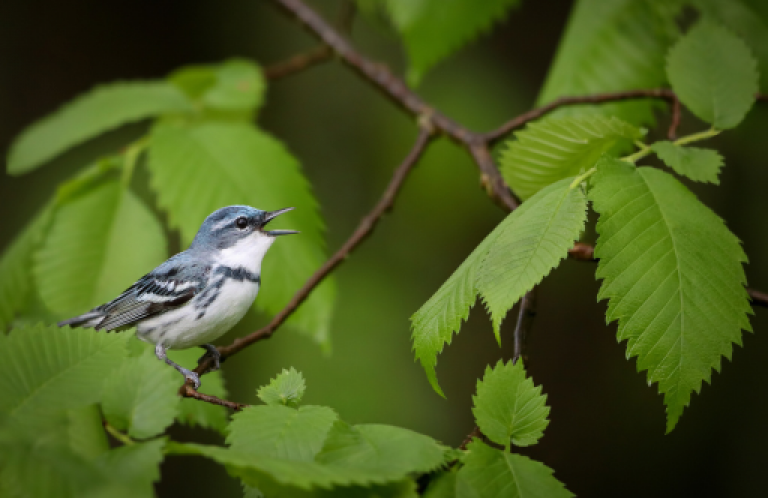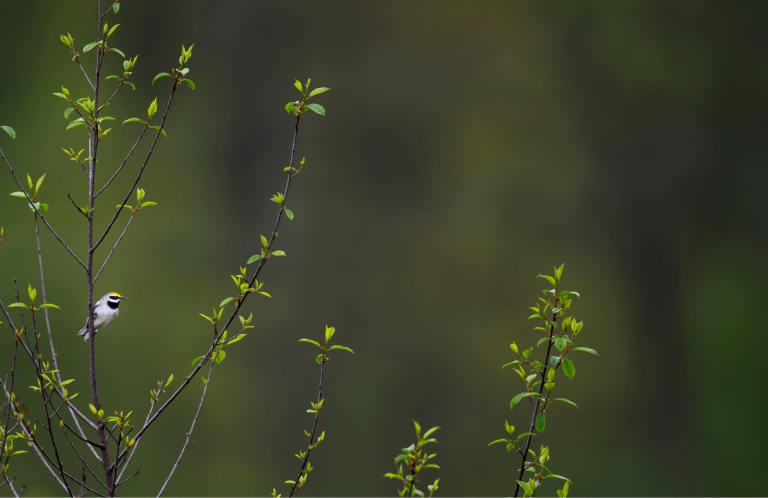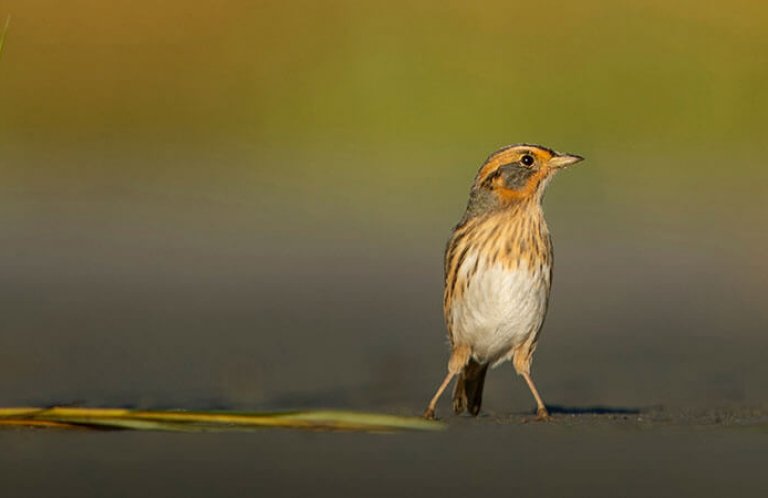Boreal Beginnings: North America's Bird Nursery
This is part of a series of explorations of different kinds of forest biomes found throughout the Western Hemisphere – and how American Bird Conservancy works to conserve them as vital bird habitats. Click to read about tropical forests, temperate forests, and different ages of forests.
Our previous stories in this series have traced the journey of one small songbird, the Blackpoll Warbler, over thousands of miles. It left its non-breeding territory in the steamy tropical forests of South America and moved north, stopping briefly in the temperate forests of the United States. Now, we will follow the Blackpoll Warbler as it heads to the final destination of its annual journey to its breeding grounds: the boreal forest.
Beginnings in the Boreal Forest
While the boreal forest is the endpoint for migration for hundreds of the Western Hemisphere's migratory bird species, it is also the place where millions of birds' lives begin each year. Nearly every Blackpoll Warbler's journey starts when it hatches in the boreal forest, the largest intact forest in the world. Here, in “North America's bird nursery,” more than 80 percent of all Blackpoll Warblers raise their young amid sprawling firs, spruces, and pines in the company of upwards of 300 other migratory bird species. Every year as the breeding season ends, millions of young birds depart the boreal forest and travel south to non-breeding grounds for the first time. They follow one of four “flyways,” time-tested routes that birds have been traveling for millennia that provide pathways from the boreal back to the tropics.
The boreal forest, also called taiga, lies slightly south of the Arctic Circle and spans most of inland Canada and Alaska. At 1.5 billion acres in the Western Hemisphere alone, the boreal forest is a treasured habitat not only for birds but also for many large mammals, including Moose, Gray Wolves, and Black Bears, species that have been driven out of many inhabited places but are integral to a healthy ecosystem.
This massive area hosts warblers and waxwings, gallinules and grouse, nightjars and nuthatches, and nearly every bird family in between in the breeding season. Seventy percent of the world's Endangered Whooping Cranes (a species numbering only about 800 individuals) breed in the boreal's shallow wetlands and marshes. Another species of the boreal, the Rusty Blackbird, has lost as much as 95 percent of its population in just four decades. Today, an estimated 85 percent of the species breed around the bogs and ponds that punctuate the mixed forests of the boreal.
A world without the boreal forest would be a world without many beloved birds.
Much More than a Forest
The term “forest” belies the breadth of all that the boreal contains. It is a vast and varied landscape covered by lush expanses of evergreens offset by the towering hardwood deciduous trees that burst with color each fall. Within the bounds of the boreal forest are fens, bogs, swamps, and marshes, winding rivers that snake through deep valleys for thousands of miles, crystal clear lakes, and freshwater coasts. All of these smaller habitats within the boreal forest are irreplaceable to the birds that breed there and the species that reside in the boreal year-round.
Conserving the boreal forest also helps people: the more than 500 billion trees that make up the boreal forest act as an incredible carbon sink, and the region is among the world's largest sources of freshwater. It is home to a quarter of the world's wetlands, including many peatlands. These waterlogged landscapes are critical in mitigating some effects of climate change: they are powerhouses of carbon sequestration and also reduce flooding risks and support clean drinking water. Peatlands are also essential for preserving precious biodiversity.
Like most forests around the world, the boreal forest faces the ever-present threat of encroaching industry. Ten million hectares of forest are lost each year to unsustainable logging, and activities from mining, oil and gas extraction, and hydroelectric development place additional strain on this delicate and specialized forest habitat.
Depending on your perspective, the boreal forest may feel like a distant, remote, and untamed place, but there are aspects of the boreal forest that touch our lives every day. We all benefit from the ecosystem services it provides and from the buffer it creates between us and worsening climate consequences. Medicine, food, and products we use in our day-to-day lives all come from the boreal. The boreal forest has also been home to Indigenous Peoples for thousands of years. The experience of these communities living on the land and stewarding its resources is invaluable to safeguarding the future of this irreplaceable landscape.
Conserving Birds From the North Pole to the South Pole
For billions of birds, the boreal forest is the first habitat they experience and the one they will return to year after year. There is no overstating the deep importance of the boreal forest to the survival of hundreds of bird species, but the boreal is one place in a continuum of forest habitats that migratory birds will need throughout their lives. There's no Blackpoll Warbler without the boreal forest, and the same is true for the temperate and tropical forests this bird visits, however fleetingly, over the course of a full year.
American Bird Conservancy works to conserve the habitat that birds need most throughout their migratory journeys, and these efforts benefit non-migratory species, too. ABC has worked with hundreds of partners throughout the Western Hemisphere. Together, we have established more than a million acres of reserves, restored degraded habitat, and improved the connectivity of habitats. We work in the places the Blackpoll Warbler needs early in its migration, in places like the Conservation Coast BirdScape in Guatemala, and in the habitats it needs mid-migration such as in the Poconos BirdScape. We know that without quality habitat, we will not be able to reverse the declines bird populations are experiencing. But the threats to birds don't stop with the loss of habitat.
By the time the Blackpoll Warbler reaches the boreal forest at the start of each breeding season, it has traveled upwards of 3,000 miles, just one part of an annual round-trip totaling 11,000 miles that includes a nonstop, nearly 2,000-mile sprint over the Atlantic Ocean. This small songbird, weighing no more than a mouse, has flown mostly at night, using the stars to navigate northward on the same route nearly every Blackpoll Warbler has traveled since long before humans arrived in the Americas.
Along the way, it may have encountered bad weather and been forced to land for the night in less than ideal habitat that made refueling for the next night's journey difficult. Bright artificial lights from cities below may have drawn it off-course. While foraging in the daytime, it may have spotted an appealing patch of trees and flown towards it, not understanding it was a reflection in a window. The warbler may have fallen prey to an unrestrained outdoor cat.
These threats are nearly universal, and not just for migratory birds. Though the impacts on migratory birds may be more visible, especially during mass collision events where hundreds of birds die in a single night, common birds in your neighborhood, wherever you might be located, are at risk, too.
Wherever you are, there are steps you can take to support the birds that live around you year-round and the ones that are passing through:
- Treat your yard like birds live there and they will thrive with the addition of native plants that provide shelter, food, and even nesting sites.
- Avoid using pesticides that can harm birds and other wildlife.
- Explore options for treating your windows to prevent collisions.
- Keep your cat inside or restrained when outside.
- Use your voice to speak out for birds.
For the Blackpoll Warbler, “habitat” can mean so many things: a Black Spruce in the boreal or a rainforest for the winter. While the types of trees and the climates of the tropical, temperate, and boreal forests may vary greatly, each of these forest biomes represents vital habitat for thousands of species.
Making Forests Work for Birds and People
The fourth and final story in our series exploring forest biomes will take us from the Northwoods of Minnesota to the Colombian Andes to learn how diversity within forests helps birds thrive, and how people can put forests to work for birds.
This is part of a series of explorations of different kinds of forest biomes found throughout the Western Hemisphere – and how American Bird Conservancy works to conserve them as vital bird habitats. Click to read about tropical forests, temperate forests, and different ages of forests.



















































